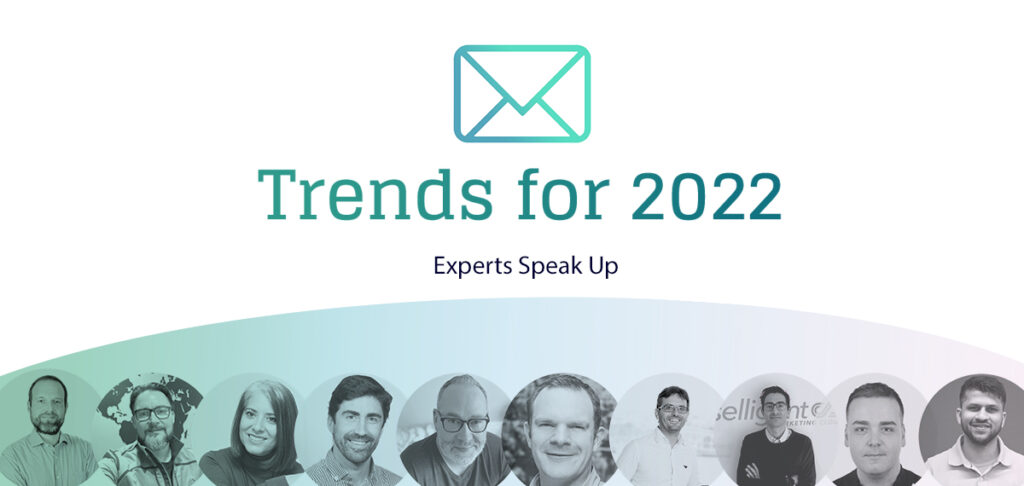Email Marketing Trends for 2022: Experts speak up

Just like every year, Digital Response would like to reflect on the key aspects that will dominate email marketing in 2022.
This time, we do so by calling on renowned professionals who wanted to share their views.

In 2021, we’ve seen how the Covid-19 pandemic has kept driving the digitalisation of companies.
Companies are continuing to embrace online marketing and sales strategies, seeking alternatives to traditional channels. However, without a doubt, one of the most fundamental channels is still email.
In our view, the trends that will be all the rage in 2022 are as follows:
Unified management of “owned channels”
We are seeing how CRM teams are taking over all communications to their own databases within so-called “owned media channels”. This includes email marketing campaigns and, increasingly, mobile app communications (push notifications, in-app messages and message centre). As brands create success stories using these types of communications, the next logical step will be to integrate them into more complex programmes that also incorporate email. In fact, brands that are ahead of the curve in terms of new marketing technologies are already implementing multi-channel programmes that send users Push notifications and/or emails depending on the stage they are at in a given journey. In 2022, we will see multichannel campaigns gain prominence.
Agile systems will be adopted for the management of the “owned media channels”
Related to the previous point, we will see how marketing operations in owned media channels are equipped with agile management systems. By marketing operations, we are referring to the set of tasks required to turn a plan, strategy or initiative into a perfectly executed (on time and error-free) campaign/journey. Marketing operations are entrusted with building audiences, sending trials, validating links, including tracking codes and other tags, converting designs into HTML documents, writing query codes so that personalisation rules and dynamic content work correctly, etc. An increase in the complexity of marketing operations will lead to the adoption of agile management systems that cut down on production times, prevent errors and boost team productivity.

CEO and Founder – Digital Response

2022 is going to be an interesting year for email marketing specialists, because the rules of the game are quickly changing. On the one hand, privacy is becoming increasingly relevant, and examples such as Apple’s “Do not track”, or privacy protection in Apple Mail, are a clear example. A user can easily choose not to send information to the brand that has sent the email, and the brand will have no way of knowing whether the user has opened the email or not. So, Open rate statistics, which were already known to be unreliable, are now even less so.
On the other hand, personalisation, and even hyper-personalisation, will continue to play a significant role in 2022. Brands that have not yet jumped on this bandwagon should do so as soon as possible to ensure that their emails are more likely to be opened. Inboxes are increasingly crowded, so the email we send needs to be relevant to our subscriber.
To gain in terms of effectiveness, in turn, interactive content within emails will cut down on clicks and therefore mean that we are more effective. The possibility of displaying a form directly in an email, without the user having to go to the landing page, opens up a whole world of possibilities. I look forward to seeing how these practices become more widespread.

Salesforce Marketing Champion – Cloud Coachers

2022 brings an air of excitement to it with the continued growth of the email marketing industry. We enter a new era of big data where no longer are the traditional email marketing platforms able to deal with the real-time nature of data transfer that yields a differentiating customer experience. Integration and orchestration win when it comes to customer experience, finding traditional email platforms and new entrants to the market becoming less data-intelligent and their value being more about operational efficiency. Timely, that Digital Response has designed a revolutionary approach to agile campaign management to inject operational efficiency to the most complex email programs.

Founder – Supero
MarTech Growth Network

Many have said that email marketing is dead. However, the truth is that it is not; not now, not in 2022 and not in the years to come.
In terms of volume, “email marketing” is always associated with bulk mailings, where segmentation, the offer itself and timing are key. Nevertheless, when it comes to Conversion, triggered emails are becoming increasingly important. Those communications based on the interactions that consumers make in e-commerce.
Of all of them, the abandoned cart recovery triggered email is the king, and it will continue to be, with a greater impact in the overall marketing strategy of online businesses.
This type of communication achieves metrics that are unusual in email marketing: Open rates above 50%, click-through rates above 25% and click-to-purchase conversion rates above 15%.
The 3 keys to achieving these indicators in 2022 will be:
1) Optimising targeting (always in compliance with GDPR).
2) Rapid sending (within one hour of abandonment).
3) Rebuild each user’s shopping cart regardless of whether or not they switch devices (cross-device experience).

Founder – Blueknow

When it comes to 2022 email marketing trends, I believe it is extremely important to take into account theincorporation of machine learning and artificial intelligence in marketing autoamted email campaigns.
The main reason is to be able to correctly segment the customers we have in the databases that the company already has, in other words, to generate groups of users with similar characteristics. Finding a cluster within the database is extremely difficult for a human being, since he/she does not have the capacity to visualise or assimilate all the dimensions of the captured data. When this process is carried out manually, a set of strict conditions is used with true or falseoutputs that doe not capture variability in customer behaviour.
Therefore, this process must be carried out through exploratory segmentation techniques known as clustering algorithms. In this way, the process is much more agile: these unsupervised machine learning algorithms are applied to the attribute vectors from which the model assigns each user a cluster number. In this way, clusters of users with very similar attributes are obtained, and these will be more similar to each other than to the rest of the clusters.
All of this makes automated email campaigns much more targeted, as users who are included in the same segment can be impacted in a more precise and personalised way.

CEO and Cofounder – InboundCycle

In 2022, interactive emails with good storytelling and gamification will matter more than the technology itself.
With Apple MPP in full effect, user data privacy will be central to all marketing decisions. As long as you follow the best practices and craft relevant content for your audience, deliverability should be a breeze in the coming year.
Because of Mail Privacy Protection, marketers will rely heavily on acquiring zero-party data from customers to design personalized and relevant shopping experiences. Loyalty programs will be the rage to acquire customer preferences in the upcoming year.
Marketers will also try to retain their high value customers in the upcoming year with better brand experience, customer support and loyalty programs.
In 2022, AI technologies in email marketing will get even more sophisticated to satisfy 1:1 customer needs for brands.
Social proofing your products inside emails will be an important strategy to generate consumer interest. Therefore, I see email and social teams working closely together in the coming year.

Sr. Product Evangelist – Netcore Cloud

Data will still be of the utmost importance to email marketers in 2022; from how they are collected across all channels, to how they are stored and, most importantly, how they are used. Brands need to be able to make predictions based on their data, use them in a way that is relevant and makes the customer feel recognised.
Customers are changing faster than ever and, in 2022, marketers need to keep up with them to respond to their preferences and behaviours. That means being able to react quickly, in real time, to send the right message, offer or relevant content at the right time.
With no end in sight to the Covid-19 pandemic, feeling connected is vital. Therefore, for marketers, Artificial Intelligence will continue to be an increasingly important tool, to deliver the kind of hyper-personalised experiences that ensure every customer interaction is meaningful and appropriate.

Sales & Partnerships Director Iberia – Selligent

The One Topic trend. Use it to build your newsletter opt-ins
One thing I saw is mayor publishers are creating separate topical (and often temporary) email newsletters. Offering a subscription to a 1 topic newsletter, or for instance only the articles from a single writer you love.They say every brand is a publisher today, but how can you use that in practice? Separate newsletters for every topic aren’t the best advice for everyone. But consider what the hot & trending topics are in your industry. It makes sense to serialize your content, even if it is evergreen blogs or pre-made on demand webinars. Mix it with updates on new pieces; just have the recurring theme in there.
Some advanced list building tools can show contextual prompts, in-text, slide in, dynamic popup alongside your topical blogs. eg: “Want to keep up to date on topic X? Subscribe here”. Or even small tools to find out the interest. With a quiz, calculator, etc. What does your audience care about? What are they concerned about? What makes them happy, angry, or interested – today, right now. Once you have established their preferences, segmentation and reader engagement will come by itself.

Email marketing consultant – Emailmonday
Founder – emailvendorselection.com

When you hear the word pollution, the first thing that comes to mind is probably plastic bags, landfills or fossil fuel emissions. However, for data-driven organisations, environmental pollution is not the only pollution out there. There is something called Dirty Data, which are data that are erroneous, inconsistent, incomplete or illegal. What happens when big data becomes bad data? With artificial intelligence, algorithms can be trained by the data and learn from them. However, what makes an algorithm work well depends largely on the quality of the data. According to Hocelot, this phenomenon leads to losses of €321 million every year in Spain, in email marketing campaigns for example.
If targeting this audience is based on data from people who have lied about their age, the messages of the marketing strategy will not be appropriate. In this context, data cleaning has emerged, comprising a set of tools and solutions that allow for the automated cleaning of dirty data. The process entails verifying a wealth of data, with technologies encompassed within Artificial Intelligence, including Machine Learning. All this leads to benefits for the company, to develop more accurate strategies, and for the user, who will have a much more satisfactory experience.

CEO – CoRegistros.com

In 2021 we saw an emphasis on privacy. Apple led the charge with iOS 15,compromising open data from Apple Mail. Privacy will continue to take precedent with Google planning to eliminate 3rd party cookies in 2023. In 2022, businesses are going to start leaning more on first party data as the source of truth for their customer insights, giving increased value to email subscribers who opt-in to content and decide what details they would like to share with businesses. In addition, businesses will have to figure out which metrics they want to optimize for as open data deteriorates, and increase focus on engagement and response rates. We’ll see AI play a role in this, from creating better personalized content that boosts responses to improving deliverability when open rates are no longer a good indicator. These are all exciting challenges and there is plenty of room for email marketing innovation in 2022.

CEO – Benchmark Email

These are the opinions and predictions of the experts on the future of Email Marketing this 2022. What are your thoughts? Do you agree? What other trends will we see?
